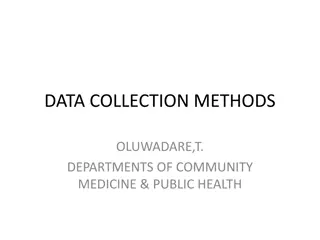Analyzing Qualitative and Quantitative Data
The findings from qualitative and quantitative data analysis. Learn how to apply analysis steps, compare platforms, and interpret results.
0 views • 33 slides
Understanding Quantitative Credit Control Methods in RBI's Monetary Policy
RBI's monetary policy revolves around maintaining credit quantity in the market through quantitative credit control methods. This includes Bank Rate Policy, Open Market Operations, Cash Reserve Ratio (CRR), and Statutory Liquidity Ratio (SLR). These tools help regulate credit flow, liquidity, and ma
4 views • 8 slides
A Primer for Designing Quantitative Research Studies
This primer introduces the processes involved in designing a quantitative study, focusing on conceptualization and design basics. It emphasizes the importance of training, coursework, and experience for conducting high-quality scholarly research. The content covers the purpose of the primer, variati
5 views • 29 slides
Understanding Quantitative Research Designs in Health Research
Quantitative research designs play a crucial role in health research, offering various methodologies like experimental and observational designs. Observational designs are commonly used and can establish associations but not causality. Longitudinal designs track outcomes over time, providing valuabl
3 views • 25 slides
Revolutionary Vitamin D Quantitative Rapid Test for Health Monitoring
SELOI HEALTHCARE PVT. LTD. offers a cutting-edge Vitamin D quantitative rapid test that provides instant results on smartphones, aiding in tracking markers and generating shareable reports within 30 seconds. With easy monitoring, multiple language support, and no setup costs, this innovative platfor
3 views • 9 slides
Overview of Research Process and Quantitative Research Phases
The research process involves steps like identifying, locating, assessing, and analyzing the research question to find answers. It includes quantitative and qualitative approaches, with specific phases like conceptual, design, empirical, analytic, and disseminating phases in quantitative research. E
9 views • 27 slides
Understanding Quantitative and Qualitative Research Methods
Exploring the differences between quantitative and qualitative research methods, this content delves into the importance of qualitative research, various methodologies such as focus groups and interviews, data collection, research ethics, and analysis techniques. It also covers the elements of the r
4 views • 43 slides
Understanding Quantitative Impact Assessment and Evaluation Methods
Quantitative impact assessments play a crucial role in measuring the effects of interventions or programs. Key types include output-based and outcome-based indicators, impact evaluations, cost-effectiveness analysis, econometric analysis, and the use of surveys and questionnaires. These methods help
0 views • 4 slides
Analyzing Two-Variable Data in Statistics and Probability
This content delves into analyzing relationships between two quantitative variables in statistics and probability, focusing on distinguishing between explanatory and response variables, creating scatterplots, and interpreting the strength and form of relationships displayed. It emphasizes the import
0 views • 14 slides
Understanding Boxplots and Identifying Outliers in Quantitative Data Analysis
Learn how to interpret boxplots, identify outliers using the 1.5 x IQR rule, and compare distributions of quantitative data. Explore examples like Barry Bonds' home run records and tablet thickness measurements to enhance your statistical analysis skills.
0 views • 21 slides
Unlocking the Power of Big Data in Teaching: Project EDDIE Workshop Insights
Delve into the impactful world of Project EDDIE, an initiative promoting data-driven inquiry in STEM education. Explore the benefits of teaching with big data, understand quantitative reasoning, and discover the objectives of EDDIE workshops. Experience the 5E model and enhance your approach to deve
0 views • 9 slides
Understanding Data Collection Methods in Health Sciences
Data collection in health sciences involves gathering raw facts systematically to answer research questions and evaluate outcomes. This includes selecting appropriate methods based on the nature of the enquiry, availability of resources, and required precision. Quantitative data collection focuses o
0 views • 28 slides
Operations Planning and Control: Forecasting Methods Overview
Forecasting is a crucial process in operations management, involving the estimation of future events based on past and present information. This chapter covers the significance of forecasts, characteristics of forecasting, role in decision-making, various forecasting methods (qualitative and quantit
3 views • 74 slides
Contrasting Qualitative and Quantitative Traits in Genetics
Genetic traits in organisms can be qualitative or quantitative, with qualitative traits controlled by single genes and showing distinct variations, while quantitative traits are influenced by multiple genes and environmental factors, resulting in continuous variations. Qualitative genetics focuses o
0 views • 13 slides
Understanding Quantitative Research Design in Social Science
This content covers various aspects of quantitative research design, including descriptive and correlational studies, research design blueprint, robust research design considerations, and different types of research approaches. It emphasizes the characteristics, techniques, and terminologies associa
0 views • 24 slides
Understanding Quantitative Analysis for Decision Making in Management
Quantitative analysis is a crucial scientific approach for managerial decision-making, involving data manipulation to derive valuable information. This method encompasses problem definition, model development, and acquiring input data. Mathematical models, variables, and parameters play key roles in
0 views • 11 slides
Qualitative vs. Quantitative Approaches in Health Research
Exploring the different methodologies, paradigms, and methods used in health research, this content highlights the distinction between qualitative and quantitative designs. It covers research questions, aims, objectives, hypotheses, and various quantitative approaches such as experimental and observ
1 views • 28 slides
Quantitative Study of Ecosystems: Techniques and Procedures
Exploring the study of ecosystems through quantitative methods like quadrat sampling and frequency analysis. Learn how to prepare, conduct fieldwork, and analyze data to understand the distribution of organisms in a selected ecosystem. This comprehensive guide covers learning objectives, safety meas
0 views • 24 slides
Understanding Research Methods: Quantitative, Qualitative, and Mixed Approaches
This introduction provides an overview of qualitative, quantitative, and mixed methods research, highlighting key differences and various types of research approaches. It delves into exploratory, descriptive, and causal research methodologies, offering insights into problem discovery, data collectio
0 views • 50 slides
Understanding Quantitative Genetics Principles in Animal Breeding
Quantitative genetics focuses on the inheritance of characteristics based on degree rather than kind, compared to qualitative genetics. It involves polygenes controlling quantitative traits, which exhibit continuous variation and can be measured using metric units. Qualitative traits, on the other h
0 views • 22 slides
Understanding Software Measurement and Metrics in Software Engineering
Software measurement plays a crucial role in assessing the size, quantity, and quality of software products and processes. It involves direct and indirect measurement methods to monitor and improve software quality, predict future outcomes, and manage project budgets and schedules. Software metrics
0 views • 8 slides
Understanding Quantitative Research in Social Studies: A Comprehensive Overview
An in-depth exploration of quantitative research methods in social studies, covering concepts, data analysis, survey techniques, causality identification, and setting up research projects. Emphasizes the importance of grasping strengths, pitfalls, and key points in quantitative research and understa
0 views • 51 slides
Quantitative Credit Control Methods in RBI's Monetary Policy
The Reserve Bank of India implements quantitative credit control methods to regulate the credit structure and maintain a balanced money supply. These methods include bank rate policy, open market operations, cash reserve ratio (CRR), and statutory liquidity ratio (SLR). By utilizing these tools, RBI
0 views • 8 slides
Primer for Quantitative Study Design: Eight Stages in the Research Process
This primer by Chosang Tendhar, Ph.D., presents an overview of quantitative study design, focusing on the eight key stages in the research process. Readers will gain insights into identifying the research problem, reviewing literature, formulating research questions, selecting study design, sampling
0 views • 29 slides
Project EDDIE: Enhancing Student Quantitative Reasoning with Large Datasets
Project EDDIE focuses on improving student quantitative reasoning through inquiry-driven exploration of complex datasets. The project aims to support instructors in guiding students to enhance their understanding of scientific concepts and quantitative skills. With a commitment to community and lear
0 views • 6 slides
Understanding and Representing Quantitative Relationships
Explore how to represent and analyze quantitative relationships using graphs, tables, and equations. Practice with unit rates, plotting points in a coordinate plane, and understanding independent and dependent variables. Develop skills in creating equations, tables, and graphs to model relationships
0 views • 120 slides
Impact of Organisational Factors on Career Success of Black Employees in South Africa
This exploratory study investigates the influence of organisational and individual factors on the subjective career success of black employees in the South African work environment. The research employs a mixed-methods design with three phases - qualitative, pilot quantitative, and main quantitative
0 views • 14 slides
Understanding Research Methods in Public Health
Exploring the nuances of qualitative and quantitative research methods in the context of public health, this content delves into how each approach offers unique insights and perspectives. It discusses the importance of qualitative research in uncovering underlying factors influencing health, interpr
0 views • 77 slides
Understanding Quantitative Data Analysis in Research
In quantitative data analysis for research, the type of research question influences the statistical methods used. Descriptive questions describe a situation without hypothesis testing. Comparative questions compare variables to assess differences, using tests like t-test and ANOVA. Relational quest
0 views • 31 slides
Understanding Data Collection Methods for Business Analysis
Data collection is essential for analyzing business performance and making informed decisions. Various data collection methods like primary and secondary data collection help evaluate outcomes and draw conclusions. Primary data includes raw information obtained firsthand, while quantitative methods
0 views • 15 slides
Writing Tips for Quantitative Methodology and Results Sections
Learn how to craft a clear and detailed methods section, identify participants effectively, address measures accurately, choose the right research design, and follow proper procedures in your quantitative research study.
0 views • 20 slides
Visualizing Quantitative Data Analysis
Explore various methods for displaying quantitative data analysis, including stem-and-leaf plots, box-and-whisker plots, dot plots, frequency tables, and histograms. Learn how to interpret these visual representations to gain insights into the distribution and characteristics of your data.
0 views • 11 slides
Instrument Development in Mixed Methods Framework by Vanessa Scherman
Mixed methods research presented by Vanessa Scherman from the University of South Africa explores the development of instruments within a mixed methods framework. The content covers an overview of mixed methods, methodological norms, instrumental development, and closing the loop. It discusses the i
0 views • 40 slides
Quantitative Research Framework for Historical Disciplines
Scholarly communities in historical disciplines are combining quantitative and qualitative methods to study phenomena that change over time. The proposed general methodological reflection aims to enhance research in historical linguistics through quantitatively driven models and claims. Quantitative
0 views • 18 slides
Understanding UV-Visible Spectrophotometry for Quantitative Analysis
Spectrometry in quantitative analysis involves determining substance concentration through spectrophotometry. UV-Visible Spectrophotometry measures light absorption in the UV or visible region using the Beer-Lambert Law, relating absorbance to substance concentration. The electromagnetic spectrum en
0 views • 15 slides
Approaches to Health Disparities in Anthropology: Quantitative vs. Qualitative Methods
Exploring health in anthropology involves various factors like social, cultural, biological, and linguistic influences. This content delves into the quantitative research on disparities in health insurance coverage, particularly focusing on Latino vs. white respondents in Texas. The study utilized l
0 views • 13 slides
Understanding the Differences Between Qualitative and Quantitative Research Methods
Qualitative research aims to understand social phenomena, while quantitative research tests hypotheses and focuses on cause and effect. Mixed methods combine both approaches for a stronger analysis. Researchers play different roles and use distinct methods and analysis techniques in each type of res
0 views • 22 slides
Empowering Through Quantitative Literacy: A Roadmap to Mathematical Empowerment
In a modern society filled with data and statistics, quantitative literacy is essential for individuals to think critically, question authority, and make informed decisions. The ability to understand and engage with mathematical concepts is crucial for addressing complex issues and thriving in today
0 views • 15 slides
Understanding Quantitative Data Analysis in Research
Dive into the world of quantitative data analysis with a focus on frequencies, central tendency, dispersion, and standard deviation. Explore the collection and analysis of numerical data, levels of measurement, and methods for quantifying social concepts. Learn about the importance of capturing data
0 views • 25 slides
Understanding and Applying Research Concepts in Social Work
This chapter delves into defining and measuring concepts in social work research, focusing on quantitative methods. It covers the importance of formulating clear research questions and hypotheses, emphasizing the need for specificity and plausibility. The chapter also discusses the significance of d
0 views • 22 slides







































